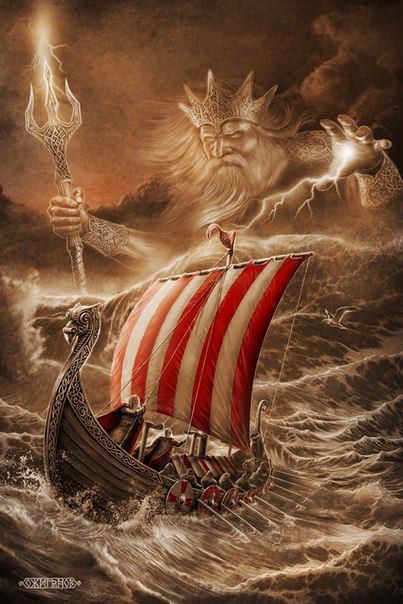
Being a man of the sea myself I have always felt my strongest connections to the Gods and Goddesses of the sea and one specifically I wanted to feature today is Njordr (Njörðr in Old Norse). Njordr is the sea God of wealth (specifically at sea), the sea and seafarers. Still to this day in such places as Iceland where fishing is very much an essential part of life, Njordr is considered a very important God of the sea. Njordr is well know in the Eddas for his relationship with Skadhi. I have always felt Njordr is not discussed as much as he should so I compiled in my opinion the best online resources for you to explore.
Njorð is of the race of Vanir and is the father of Freyr and Freyja. He is the god of the sea. He calms storms, aids ships in distress, and causes favorable winds to blow. As with the other Vanir, Njorð is a fertility god, capable of providing good fortune in the form of safe sea voyages, wealth, and land.
When hostages were exchanged at the end of the war between the Æsir and the Vanir, Njorð and his two children came to live in Ásgarð with the Æsir. The mother of Freyr and Freyja was probably Nerthus, Njorð’s sister. Æsir disapproval of such practices prevented her from coming to Æsir with the rest of the family. Later, Njorð married a second time. Snorri Sturluson tells the story in Skáldskaparmál.
When Þjazi, the giant who kidnapped Idun, did not return home after giving chase to Idun and her rescuer Loki, Þjazi’s daughter Skadi began to worry for his safety. Soon, she realized that he must be dead. Swearing vengeance, she took up her father’s arms and traveled to Ásgarð.
Heimdall saw her approach and sounded a warning. Several of the gods went out to meet her. Having no wish to prolong the feud, the gods asked if she would accept wergild (gold as payment for her father’s death).
Skadi said she would settle instead for a husband of her choice from amongst the gods. The gods agreed, provided that Skadi chose her husband by looking only at his feet. Continue reading HERE.

Njord Sea God Norse Mythology
Ship Herd
The gulls bring word of you who widely fares
to tell the fishes where to find our net;
they’ve come from Noatun to claim their shares,
like you at home both in the dry and wet.
Within your waters play the Sisters Nine
who bask in rising Sunna’s brilliant blush,
as waves frolic in the golden shine
until the purple nightfall’s gentle hush.
O tranquil Lord of seven surging seas,
send wind to fill our sails, and grant us all
to pass to our ports with grace and ease
over the depths of Ran’s and Aegir’s Hall.
And let us in the midst of storms be stout,
firm as an anchor in the shifting sands,
that change and stay the same, tide in, tide out,
beneath your briny realm that bounds the lands.
© 2009 Michaela Macha of Odin’s Gifts
Further Resources
Njord: The Tumultuous Marriage of a Norse God of the Sea and a Goddess Giantess
Norse Mythology for Smart People: Njord



